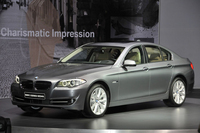Preview: World Premiere 2011 BMW 5 Series Sedan - VIDEO ENHANCED
By Henny Hemmes
Senior European Editor
MUNICH - November 25, 2009: When Dr. Klaus Draeger, board member of BMW AG, is presenting a new car or some new technology, he is inspiring his audience with his enthusiasm.
 Dr Klaus Draeger |
Today, the endearing German presented the new 5 Series Sedan for the first media group in the Forschungs- und Innovations Zentrum FIZ of the Group in Munich, that he calls his second home: “Here, in the heart of BMW development and BMW design, function and design of future models come together. We call this building the ‘project house’ and, by the way, my office is on the other side of that wall just down the hall.” Dr. Draeger said that we all know that the first impression counts, that design plays a crucial role in buying a car and that customers look for a product that combines appeal with functionality.
The 5 Series debuted in 1972 and the model line is of major strategic and economical significance to the Bavarian car manufacturer, together with the 3 Series and the 1 Series. “They account for just over half of our profit margin,” said Dr. Draeger.
Click PLAY to watch the new 5 Series Sedan on the road
Design talk
 Adran van Hooydonk |
 Anders Warming |
The new generation of the 5 is the evolution of the design philosophy that was initiated by Chris Bangle, the BMW Group’s design chief who was succeeded in March by Adrian van Hooydonk. As was the case with the new 7 Series, also the 5 lacks the radical boot lip, while its proportions are well balanced and the lines are clean with two main creases along the side of the car, but the main one is not – like the 7 starting at the far front. Van Hooydonk volunteered that since the 5 series now looks more dynamic, the new 3 Series therefore will be even sportier…
Pedestrian safety
Apart from other goals, the design also had to meet
the technical parameters that are required for pedestrian safety in Europe
now. That is why design met functionality by way of the creases in the
aluminium bonnet, that are placed right on top of the highest parts, the
shocks and the engine. This created a space in order to provide a crash
zone for pedestrians. The low aluminium bonnet helps in a way that it is
more flexible on impact than steel. Fröhlich also pointed out that the
sportier look is taken on the side of the car by third side window that
goes further into the rear than that of the current 5 Series. In the dark,
the LED rings around the dual head lights and the L-shaped LED rear lights
should make it clear that they belong to the new 5 Series Sedan.
 Oliver Heilmer |
Fröhlich’s colleague Oliver Heilmer signed for the interior design of the new sedan. Earlier he was in the spot light with his interior of the X6. Just like Fröhlich the young stylist is eager to show the dashboard, that, as, he said: “is like in all BMW’s driver oriented. With 7 degrees, this one is really mild, but it provides a sporty elegant feel.” While he points at the top of the dashboard, Heilmer says: “Because of the possibility to use new anti glare lamina for the 10.2 inch control display in the center console, the overhang above could be much smaller than before, providing a more horizontal look.” The interior benefits of the longer wheelbase, with 116.85 inches the longest in its class. It results in 0.51 in. extra space for the rear passenger’s legs.
Powerbench
 Jacek Fröhlich |
We were also taken to a solid model referred to as ‘cubing’ . The model in its original size is made of the synthetic material uriol and rests on a flexible frame with adjustable fasting points allowing quick and low-cost configuration of the respective model. Anders Warming showed us an example: he took a small card the size of a credit card and went over de spaces, such as the small part that pops up when the head light washer system is activated. That way he can feel if the part has the right curvature. But also the spaces between different body parts can be felt and marked for adjustment. Cubing allows for constantly refining of the parts.
An example of optimised design in the Powerbench and on the three-dimensional model is the transition from the instrument panel to the door linings. Oliver Heilmer points at the interior part. The horizontally aligned structure and the stretched lines of the instrument panel flow through the door linings all the way back to the rear, the occupants thus experiencing the entire interior as one harmonious entity.
To optimise this feeling of space, the challenge was to integrate the joint between the instrument panel and the door lining indispensable for functional reasons into the harmonious overall look of the interior.
By presenting us the various techniques that are involved in the complete development of a new car, it is easier to understand why the process takes time. But with only three years for the new 5 Series Sedan, BMW is not one of the slowest in the industry. On the contrary. Now we will have to wait a bit for the first possibility to drive the 5 Sedan. It will take place in Portugal in the second half of January. We are looking forward. Stay tuned.



